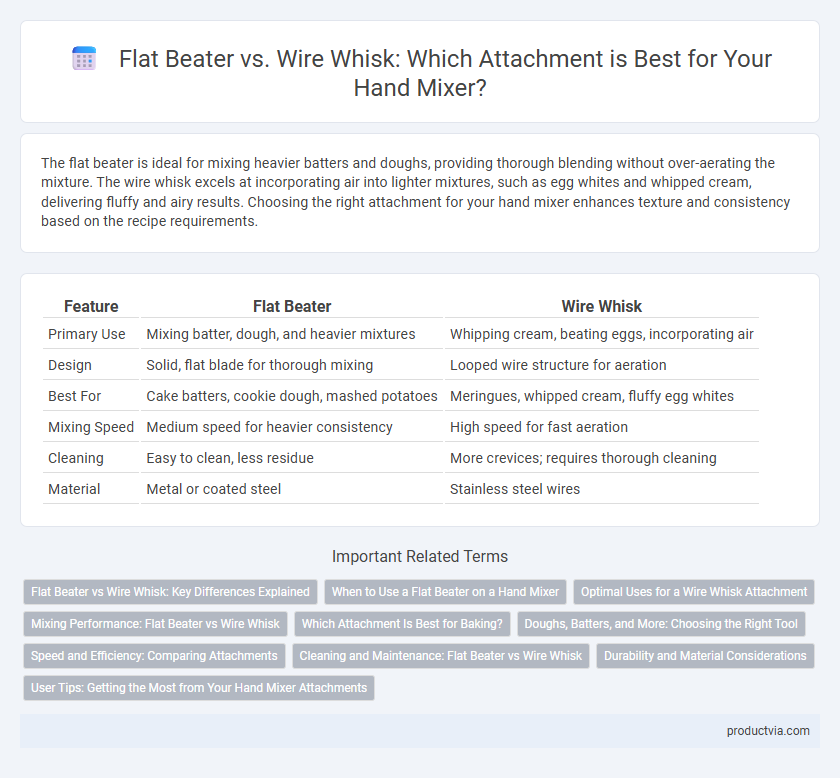The flat beater is ideal for mixing heavier batters and doughs, providing thorough blending without over-aerating the mixture. The wire whisk excels at incorporating air into lighter mixtures, such as egg whites and whipped cream, delivering fluffy and airy results. Choosing the right attachment for your hand mixer enhances texture and consistency based on the recipe requirements.
Table of Comparison
| Feature | Flat Beater | Wire Whisk |
|---|---|---|
| Primary Use | Mixing batter, dough, and heavier mixtures | Whipping cream, beating eggs, incorporating air |
| Design | Solid, flat blade for thorough mixing | Looped wire structure for aeration |
| Best For | Cake batters, cookie dough, mashed potatoes | Meringues, whipped cream, fluffy egg whites |
| Mixing Speed | Medium speed for heavier consistency | High speed for fast aeration |
| Cleaning | Easy to clean, less residue | More crevices; requires thorough cleaning |
| Material | Metal or coated steel | Stainless steel wires |
Flat Beater vs Wire Whisk: Key Differences Explained
Flat beaters excel at mixing dense ingredients and achieving smooth batters, making them ideal for cookie dough and cake mixes, while wire whisks efficiently incorporate air into lighter mixtures such as egg whites and cream. The flat beater's solid, paddle-like design provides thorough blending without over-aerating, whereas the wire whisk's looped wires create volume and fluffiness by aerating. Choosing between flat beater and wire whisk depends on the specific baking task, with flat beaters suited for heavy mixing and wire whisks optimized for whipping and aeration.
When to Use a Flat Beater on a Hand Mixer
Use a flat beater on a hand mixer for mixing medium to heavy batters, such as cookie dough, cake batter, and mashed potatoes, where thorough blending and consistent texture are essential. The flat beater effectively incorporates ingredients without introducing excessive air, resulting in smooth, dense mixtures. It is ideal for tasks requiring gentle but firm mixing to maintain ingredient integrity and achieve uniform consistency.
Optimal Uses for a Wire Whisk Attachment
The wire whisk attachment excels at incorporating air into mixtures, making it ideal for whipping cream, beating egg whites, and creating meringues with maximum volume and lightness. Its design efficiently aerates batters and emulsifies ingredients, resulting in fluffy textures perfect for souffles and delicate desserts. Using a wire whisk with a hand mixer optimizes mixing speed and consistency for recipes requiring vigorous aeration.
Mixing Performance: Flat Beater vs Wire Whisk
The flat beater delivers superior mixing performance for heavy batters, doughs, and thick mixtures due to its sturdy design and broad surface area, ensuring thorough and even blending. The wire whisk excels at incorporating air into lighter mixtures such as whipped cream, meringues, and egg whites, creating a fluffy texture with rapid aeration. Choosing between a flat beater and wire whisk depends on the consistency of the ingredients and desired texture, optimizing efficiency and outcome in hand mixer usage.
Which Attachment Is Best for Baking?
The flat beater attachment is best for mixing dense batters like cookie dough, cake mixes, and mashed potatoes due to its sturdy, broad design that ensures thorough blending without incorporating excess air. The wire whisk excels in whipping tasks, efficiently aerating mixtures such as egg whites, cream, and meringue to achieve light, fluffy textures. Choosing the right hand mixer attachment depends on the recipe's texture requirements: flat beater for thick, heavy batters and wire whisk for aerated, fluffy mixtures.
Doughs, Batters, and More: Choosing the Right Tool
Flat beaters excel at mixing dense doughs and thick batters, efficiently combining ingredients without overworking the mixture. Wire whisks are ideal for incorporating air into lighter batters and whipping cream or egg whites to fluffy peaks. Selecting the right attachment for a hand mixer ensures optimal texture and consistency in a variety of baking and cooking tasks.
Speed and Efficiency: Comparing Attachments
Flat beater attachments deliver efficient mixing at moderate speeds, ideal for heavy batters and doughs, ensuring thorough ingredient incorporation without overworking. Wire whisks excel at high speeds, rapidly aerating mixtures like egg whites and cream, producing lighter, fluffier textures with less effort. Choosing between a flat beater and wire whisk depends on the recipe's requirements for speed and texture precision during mixing.
Cleaning and Maintenance: Flat Beater vs Wire Whisk
The flat beater, with its solid, smooth surfaces, is easier to clean and less prone to food residue buildup compared to the wire whisk, which features multiple thin wires that can trap batter and require more thorough scrubbing. Stainless steel flat beaters resist rust and are dishwasher safe, simplifying maintenance and ensuring durability. Wire whisks often need careful hand washing to prevent bending or damage, and thorough drying is essential to avoid corrosion.
Durability and Material Considerations
Flat beaters are typically constructed from sturdy stainless steel or coated metal, providing high durability and resistance to bending or warping during heavy mixing tasks. Wire whisks are often made from flexible stainless steel wires, which excel in aerating ingredients but may be less durable under high-torque conditions or dense mixtures. When choosing between the two, consider the material thickness and coating of flat beaters for longevity, while wire whisks require careful handling to maintain their shape and effectiveness.
User Tips: Getting the Most from Your Hand Mixer Attachments
Flat beaters excel at mixing cake batters, cookie dough, and mashed potatoes, providing smooth and even blending with minimal effort. Wire whisks are ideal for whipping cream, egg whites, and sauces, incorporating air to achieve light and fluffy textures quickly. To extend the life of your hand mixer attachments, always start at a low speed when adding ingredients, avoid overloading the mixer, and clean the attachments immediately after use to prevent residue buildup.
Flat beater vs Wire whisk for hand mixer Infographic

 productvia.com
productvia.com